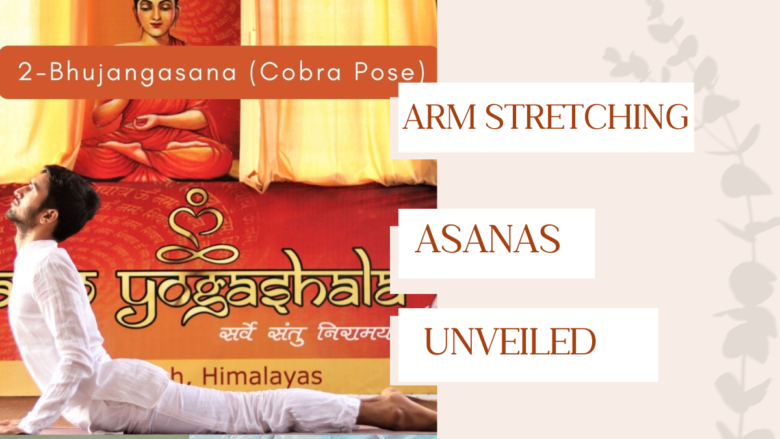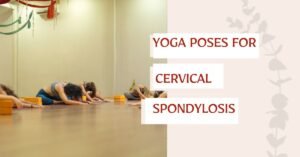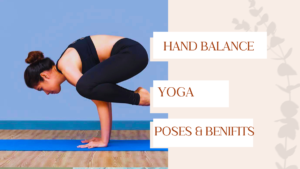Yoga, a timeless art offered by Aatm Yogashala, paves the way to holistic wellness. Within its rich tapestry, postures where arms are stretched upwards, such as in certain asanas, stand as pillars of strength and openness.
For many, this image of arms reaching toward the sky symbolizes a quest for the divine within. These movements, integral to the practice, facilitate both physical and spiritual expansion.
This comprehensive guide, brought to you by Aatm Yogashala, aims to shine a light on the myriad benefits that arm stretches, especially in asanas where arms are stretched upwards, can add to your yoga journey, encouraging you to delve into the length and breadth of this essential element.
In which asana arms are stretched upwards
The Urdhva Hastasana or Upward Salute, is a basic pose where the arms stretch up, enhancing flexibility and boosting energy. Practitioners reach their arms high, tapping into their inner strength and spreading vitality through the body. This pose is a grounding and uplifting element in many yoga sequences, embodying the pursuit of one’s higher self.
Benefits of Arm Stretches in Yoga
Incorporating arm stretches into your yoga routine has manifold benefits that resonate through both the mind and body. Physically, these movements enhance upper body strength, improve flexibility in the shoulders, elbows, and wrists, and promote better circulation.
They play a critical role in alleviating tension accumulated in the upper body, particularly for those who spend extensive hours at a desk or in front of a computer. Mentally, arm stretches help to clear the mind, reduce stress, and elevate mood by fostering a deeper connection with one’s breath and body awareness.
Spiritually, extending the arms upward or outward can symbolize an opening to receive energy, fostering a state of receptivity and surrender. Engaging in these practices regularly can lead to a profound sense of balance and harmony within the self.
Recommended Arm Stretches in Yoga
Gomukhasana (Cow Face Pose): This seated posture involves clasping the hands behind the back, stretching the arms and shoulders while simultaneously opening up the chest and heart center.
Garudasana (Eagle Pose): This asana involves wrapping one arm under the other, crossing at the elbows and wrists. It stretches the shoulders and upper back while also engaging the core.
Anjali Mudra (Salutation Seal): A simple yet powerful gesture of bringing the palms together at heart center, this mudra symbolizes unity and balance within oneself.
Bhujangasana (Cobra Pose): This backbend pose involves stretching the arms by pushing the chest and head upwards. It strengthens the arms, shoulders, and upper back while also promoting spine health.
Step-by-Step Instructions for Practicing Arm Stretches
Arm stretches can be easily integrated into your yoga practice with these simple step-by-step instructions. For beginners, these movements offer a gentle start, while advanced practitioners can deepen their stretch and improve flexibility over time.
Gomukhasana (Cow Face Pose)
Begin Seated: Sit with a straight spine, legs extended in front of you.
Bend Knees: Bend your knees and slide your left foot under your right leg to the outside of your right hip. Then, stack your right knee on top of your left, bringing your right foot to the outside of your left hip.
Stretch Arms: Stretch your right arm upwards and then bend the elbow, bringing your hand down your back. Stretch your left arm out to the side, bend the elbow, and bring your left hand up the middle of your back.
Clasp Hands: Try to clasp your hands behind your back. If your hands do not comfortably meet, use a yoga strap or towel.
Hold and Release: Hold the position for 30 seconds to a minute, deepening the stretch with each breath. Release and repeat on the opposite side.
Garudasana (Eagle Pose)
Begin Standing: Stand tall with feet slightly apart and arms at your sides.
Bend Knees: Slightly bend your knees and cross your left thigh over your right thigh. If possible, hook your left foot behind your right calf.
Cross Arms: Extend your arms straight in front of your body, then cross your right arm over your left, bending elbows so they are perpendicular to the floor. Wrap your right forearm around your left and bring your palms to meet.
Focus and Balance: Maintain a steady gaze (drishti) to help with balance. Sink deeper into the pose with each breath, squeezing your thighs together and lifting your elbows to shoulder height.
Hold and Release: Stay in this pose for 15 to 30 seconds, then gently unwind and repeat on the other side.
Anjali Mudra (Salutation Seal)
Start in Any Comfortable Position: This gesture can be performed standing, seated, or even in a yoga pose such as Tadasana (Mountain Pose).
Bring Palms Together: Bring your palms together at the heart center, with fingers pointing upwards. Keep the elbows relaxed and slightly out to the sides.
Focus on the Breath: Close your eyes and take several deep breaths, focusing on the sensation of the palms touching and the chest opening.
Hold: Maintain this position for a few minutes, using it as a moment of reflection or intention setting for your practice.
Bhujangasana (Cobra Pose)
Begin on Your Stomach: Lie flat on your stomach, with your legs extended back and the tops of your feet pressing into the mat.
Place Hands Under Shoulders: Place your palms on the mat directly under your shoulders, keeping your elbows close to your body.
Lift Upper Body: Inhale and gently lift your head, chest, and shoulders off the mat, straightening your arms as much as possible without locking them. Relax your shoulders away from your ears.
Hold and Breathe: Hold this position for a few breaths, deepening the stretch with each exhale. Focus on keeping your arms engaged and your core activated.
Release: Slowly release the pose by lowering your upper body back to the mat on an exhale. Repeat as desired.
Common Mistakes in Practicing Arm Stretches
While arm stretches are beneficial for enhancing flexibility and strength, there are common mistakes that can diminish their effectiveness or even lead to injury. Awareness and correction of these errors can significantly improve your yoga practice.
Overstretching: Pushing your body beyond its limits can cause strain or injury. Listen to your body and respect its boundaries.
Improper Alignment: Neglecting proper alignment, especially in poses like Gomukhasana and Garudasana, can lead to undue stress on your joints. Ensure your shoulders and elbows are correctly positioned according to the pose requirements.
Holding Breath: Forgetting to breathe or holding your breath limits oxygen flow and can make the stretch more challenging. Maintain steady, deep breaths to help with relaxation and deepen the stretch.
Skipping Warm-Up: Arm stretches require a degree of flexibility and strength. Skipping a general warm-up can lead to muscle strain. Incorporate some gentle movements to prepare your body before engaging in more intense stretches.
Using Force: Avoid using excessive force to achieve a pose, especially when trying to clasp hands in Gomukhasana or reaching for the toes in forward bends. Use props like straps to bridge the gap and gradually work your way towards the full expression of the pose without force.
Safety and Precaution in Yoga Practice
When integrating arm stretches into your yoga routine, it’s crucial to prioritize safety and heed certain precautions. This mindful approach not only enhances your practice but also prevents potential injuries. Here are key safety tips and precautions to consider:
Listen to Your Body: The fundamental rule in yoga is to listen to and honor your body’s signals. If you experience pain or discomfort, gently come out of the pose and try an alternative stretch or use modifications.
Use Props: Don’t hesitate to use props such as yoga straps, blocks, or bolsters to support your practice. These tools can help maintain proper alignment and make poses more accessible.
Engage in Gradual Progression: Progress through poses gradually, especially if you’re a beginner. Start with basic stretches to build flexibility and strength before attempting more advanced poses.
Consult a Healthcare Professional: If you have existing injuries, chronic pain, or other medical conditions, consult with a healthcare professional before beginning a new yoga practice.
Practice Under Guidance: For beginners, practicing under the guidance of an experienced yoga instructor can provide valuable feedback on form and alignment, decreasing the risk of injury.
Focus on Alignment: Proper alignment is more crucial than achieving the full expression of a pose. Prioritize the correct placement of your body parts over depth to safeguard against strain.
Warm-Up: Always begin your yoga session with a warm-up to prepare your body. Gentle stretches and movements can increase blood flow, improve flexibility, and decrease the risk of injuries.
The Crucial Role of Arm Stretches
In the symphony of yoga poses, arm stretches act as keynotes, harmonizing the upper body with the core and lower limbs. These stretches not only enhance flexibility and strength but also stimulate pranic flow, or the life force energy, through the body. When engaged mindfully, upward-reaching asanas open the heart space and encourage a deeper sense of connection to both ourselves and the world around us.
Understanding the Physiology
Each arm stretch engages a network of muscles and fascia, promoting better circulation and releasing stress. From the deltoids to the triceps, and through the interplay of the arms with the spine and torso, these poses lead to improved posture, which is crucial for spinal health and the vitality of the organs that line the chest and abdomen.
Beyond the Body: The Mental and Spiritual Benefits
Physical prowess is but one facet of arm stretches in yoga. These postures can lead to an expanded sense of mental well-being, as the act of reaching upward is often associated with aspirations, positivity, and a feeling of elevation. It can also be a profound practice in surrender and trust, as we learn to lean into discomfort and breathe through the sensation.
The Art of Arm Stretching
When art meets science in the practice of yoga, every movement becomes an opportunity for growth. Here, we will explore the more intricate details of the common arm stretches and learn how to refine our approach for maximum benefit.
Effective Upper-Body Poses to Master
From the dynamic movement of Urdhva Hastasana (Upward Salute) to the resolute stability of Virabhadrasana II (Warrior II), a spectrum of arm stretches can be incorporated into your routine. We’ll break down the steps and nuances of these poses, honing in on the alignment of the arms, the engagement of the core, and the steady gaze that anchors the practice.
Techniques for Deepening the Stretch
To evolve in your arm-stretching practice, paying attention to detail is paramount. We will explore techniques for incrementally deepening each stretch, such as using props to aid a pose, progressively adding more complexity, and harnessing the power of breath to flow into the spaces of resistance.
Integration into Your Daily Yoga Practice
A consistent practice is the soil in which the flower of yoga blossoms. Here, we will discuss how to integrate arm stretches into your daily routine, so that these postures become a natural extension of your flow and not a mere addition.
Crafting a Sustainable Practice
Just as a skilled gardener tends to the specific needs of each plant, you must care for your yoga practice. Choosing when to incorporate arm stretches, ensuring adequate warm-up, and offering recovery are all second-nature for a practice that endures life’s ebbs and flows.
In Sync with the Sun and Moon
Drawing inspiration from nature, aligning your arm-stretching sequences with the cycles of the sun and moon can infuse your practice with a sense of vitality and balance. Morning stretches symbolize new beginnings, while evening stretches mirror the quiet surrender to restorative darkness.
Hearing from the Community
The beauty of yoga lies in its universality. We will hear from fellow practitioners, sharing their stories of transformation through arm stretches, and learn from their wisdom and experiences.
Conclusion: Ascending with Arm Stretches
We conclude our exploration with a call to action, encouraging readers to leverage the wisdom shared and to share their own experiences with others. Collectively, we can create a community that upholds the tradition and innovation of yoga, supporting each other on the path to growth and well-being.
Join our internal 200-hour Yoga Teacher Training Course to deepen your understanding of arm stretches and establish a foundation for guiding others on their yoga journeys. Aatm Yogashala is dedicated to preserving the purity of traditional yoga with a contemporary touch, and we welcome all seekers of transformation. Visit our website to learn more and to become part of our global yoga family. Namaste.
Frequently Asked Questions (FAQs)
What are the best arm stretches for beginners?
The best arm stretches for beginners include Urdhva Hastasana (Upward Salute), which gently stretches the arms, shoulders, and chest, and Baddha Hastasana (Bound Hands Pose), ideal for opening the shoulders and improving posture. These poses are accessible for individuals at any fitness level, offering a safe start to exploring arm stretches in yoga.
How often should I practice arm stretches?
Incorporating arm stretches into your daily yoga routine is recommended for optimal benefits. Even a few minutes devoted to these stretches can improve flexibility, strength, and mental focus. However, listening to your body and adjusting based on your physical and mental state is crucial.
Can arm stretches help with wrist pain?
Yes, many arm stretches can alleviate wrist pain by strengthening the muscles around the wrists and increasing flexibility. Poses such as Garudasana (Eagle Pose) and Viparita Namaskarasana (Reverse Prayer Pose) are beneficial for relieving wrist pain.
Is it okay to use props during arm stretches?
Yes, using props such as blocks, straps, and blankets can aid in deepening the stretch and finding proper alignment. Props can also be helpful for beginners or individuals with limited flexibility. As with any yoga practice, it is important to listen to your body and use props as needed. So, don’t hesitate to incorporate them into your arm-stretching routine.
Can arm stretches have mental benefits?
Absolutely! Arm stretches in yoga can lead to an expanded sense of mental well-being through the act of reaching upward and surrendering into discomfort. They can also promote a sense of calm and release tension in the mind and body. The combination of movement, breath, and focus during arm stretches can also bring about mental clarity and improved concentration. So, not only do your arms benefit from these stretches, but your mind does too.




